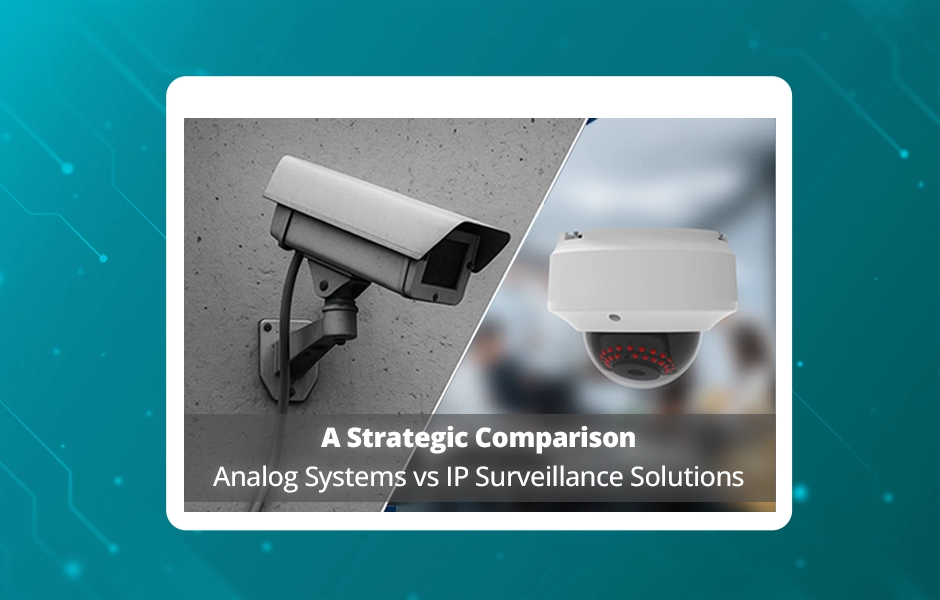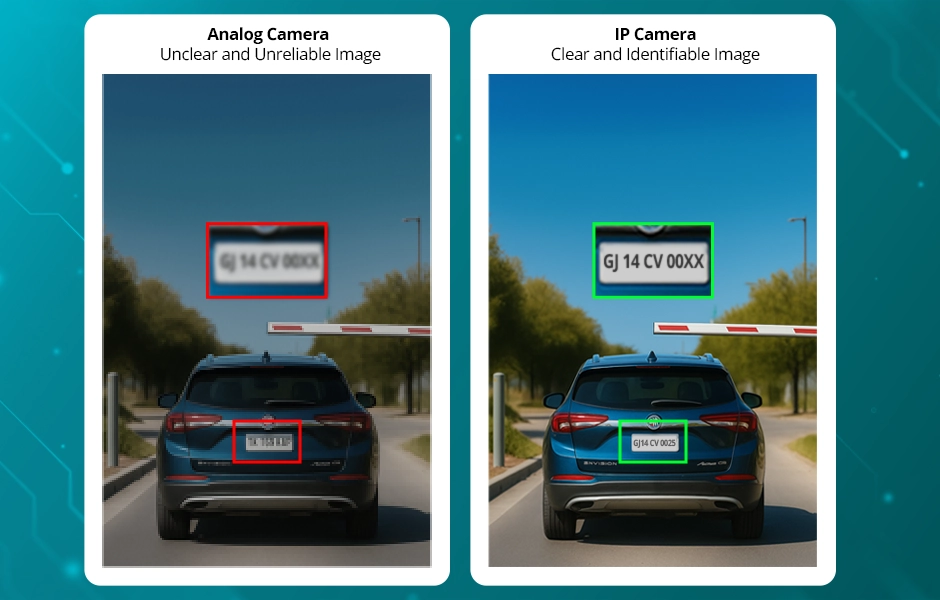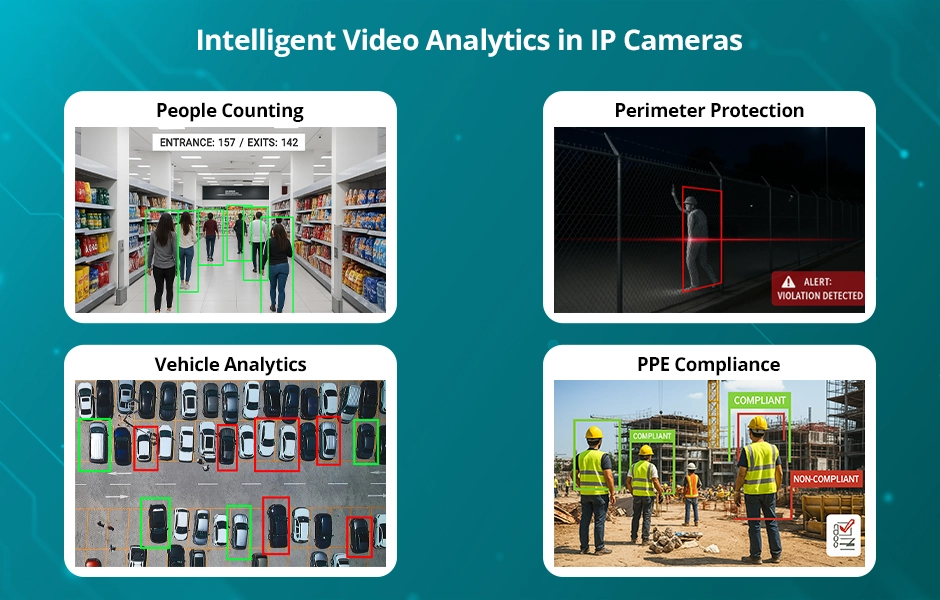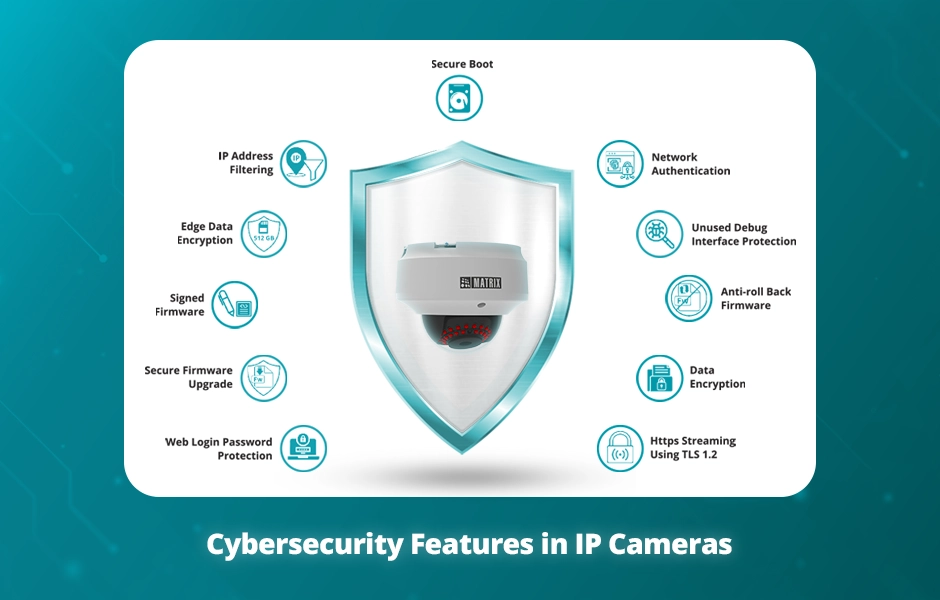
In 2025, when AI-powered analytics and HD streaming are the norm, one question still echoes through security departments:
“Why switch from analog cameras to IP cameras when it still works?”
It’s a fair question. After all, analog CCTV has been the workhorse of surveillance for decades — dependable, familiar, and affordable. But as buildings get smarter and threats more complex, those same systems are showing their age. Grainy footage, limited range, and DVR failures have turned yesterday’s convenience into today’s constraint.
The global analog security camera system market is poised for significant expansion, projected to reach an estimated value of approximately $6,500 million by 2025, with a compound annual growth rate (CAGR) of around 7.5% anticipated for the forecast period of 2025-2033. (Data Insights Market, 2024). Yet, despite this modest growth, IP-based surveillance now dominates new deployments, expanding at a rate of 14–16% annually (Omdia, 2024).
If you’ve ever struggled with unclear video, lost data, or costly upgrades, this guide is for you.
What’s the Real Difference Between Analog Cameras and IP Cameras?
| Feature | Analog Cameras (CCTV) | IP Cameras (Network Surveillance) | What This Means for You |
| Signal Type | A continuous electrical signal is sent to a DVR | Digital data packets created at the camera | IP delivers cleaner images, with no signal loss over distance. |
| Compression & Codec | MJPEG or proprietary formats | H.264 / H.265 / H.265+ | More efficient bandwidth use and smaller file sizes. |
| Power & Cabling | Separate coax + power cables | Single PoE/PoE+/PoE++ (IEEE 802.3af/at/bt) cable | One-cable simplicity and lower labor costs (~40%). |
| Data Processing | Centralized at DVR | Edge processing with onboard CPU | Cameras analyze activity locally for faster alerts. |
| Storage Options | Local DVR only | Edge SD, NVR, or Cloud | Flexible storage and easy redundancy. |
| Cybersecurity | None; analog signals unencrypted | TLS 1.2+, AES 256-bit, ONVIF Profile T | Encrypted end-to-end video, authenticated devices. |
| Scalability | Limited by DVR ports | Virtually unlimited via network switches | Add or relocate cameras without requiring a redesign of the wiring. |
For analog cameras, every upgrade requires new cables, new DVR ports, and manual troubleshooting. It’s the equivalent of using a landline in a world that runs on cloud calls.
Why More Businesses Are Switching from Analog Cameras to IP Cameras
1. How Image Resolution and Coverage Affect Security
If you’ve ever zoomed into an analog clip only to find a blur where a face should be, you already know this pain. Analog video maxes out at 4 MP (1080p), and signal quality degrades over long coaxial runs.
IP cameras start at 2 MP and go beyond 4K (8 MP). They transmit digital data with zero image loss and use compression formats like H.265, cutting storage needs in half. A single 4K IP camera can cover what three analog units would — fewer devices, less wiring, better evidence.
(Markets and Markets, Video Surveillance Report 2024)
2. How AI and Intelligent Video Analytics Turn IP Cameras into Smart Watchers
Most analog cameras are purely reactive — they record what happened but can’t alert you while it’s happening.
IP cameras change that equation. Equipped with Intelligent Video Analytics (IVA), and AI, they identify people, vehicles, and events in real time. They can detect unusual behavior, count people, or even check PPE compliance on a factory floor. IP cameras are also powering modern applications like crowd analytics and Smart Parking Management Systems, where automation, efficiency, and situational awareness work together to enhance safety and control.
The AI in Video Surveillance market will reach USD 12.46 billion by 2030, up from USD 3.9 billion in 2024 (Omdia). That shift is driven entirely by IP camera adoption because analog cameras can’t run analytics without costly external processors
3. How Power over Ethernet (PoE) Simplifies CCTV Installation
Analog camera users know the pain of rewiring. Every new camera means another power adapter, another run of coax, and sometimes even another DVR — making expansion almost as costly as replacement.
With Power over Ethernet (PoE), IP cameras transmit both power and data through a single cable. According to the Security Industry Association (2024), PoE and PoE+ reduce installation labor by 30–40%, cutting clutter and complexity.
Scaling up? Just add a network switch or connect directly to a Network Video Recorder (NVR) that supports PoE ports for plug-and-play deployment. Managing multiple sites? View them all from one dashboard — no messy cables, no ceiling rewiring, no downtime.
4. How Cybersecurity Protects Modern IP Surveillance
Analog cameras are like open books — unencrypted signals that anyone with access to the cable can intercept. In an era of cyber threats, that’s a serious liability.
IP cameras, by contrast, follow global security standards like ISO/IEC 27402, TLS/HTTPS encryption, VLAN segmentation, and ONVIF Profile T compliance.
Governments worldwide are tightening regulations, and in India, certification has moved from recommendation to requirement. The STQC certification for IP cameras now serves as a national benchmark, ensuring devices meet strict parameters for cybersecurity, component sourcing, chipset integrity, and supply chain transparency. These standards don’t just protect data; they protect trust — guaranteeing that every stream of surveillance footage is secure, authentic, and compliant with evolving regulatory frameworks.
IP Cameras vs. Analog Cameras: Understanding Cost, ROI, and Long-Term Value
If you’ve ever replaced a DVR because it maxed out or reinstalled cables for a warehouse expansion, you’ve already paid the hidden cost of analog.
Labor and cabling make up 60–70% of analog installation expenses (Anixter, 2024). Add the maintenance burden — DVR failures, manual footage recovery, and no remote access — and analog’s low upfront cost quickly becomes misleading.
| Cost Factor | Analog System | IP System | What This Means for You |
| Upfront CAPEX | Lower camera/DVR cost | Slightly higher (PoE + NVR) | Pay once, scale later. IP lasts 2–3x longer. |
| Cabling & Labor | Dual runs, multiple power points | Single PoE line | Save ~40% installation time and labor. |
| Power Usage | Multiple adapters | Centralized PoE switch | Lower energy cost, easier backup power. |
| Maintenance | Frequent DVR failures | Remote firmware & diagnostics | Eliminate site visits and manual resets. |
| Scalability | Port-limited | Network-based expansion | Add cameras without infrastructure change. |
| 5-Year Lifecycle Cost | Higher total OPEX | 11–15% lower (TCO Study, 2024) | IP breaks even after ~14 cameras. |
Why Modern IP Cameras Are Smarter Than Traditional Analog Systems
Modern IP cameras don’t just record — they respond. They automatically adjust to changing light, keeping every frame clear whether it’s bright daylight or near darkness. Features like Wide Dynamic Range (WDR) prevent glare, while cameras equipped with advanced sensors like SONY STARVIS capture clear details even at night. Smart compression (H.265+) reduces file size without losing quality, saving bandwidth and storage. Power over Ethernet (PoE++) delivers both power and data through a single cable, keeping installations neat, and Edge Storage ensures footage continues recording even if the network drops. Analog systems simply weren’t built for this kind of adaptability. They work, but they don’t think. IP cameras, by contrast, learn and evolve through regular software updates, turning traditional surveillance into a truly intelligent network.
When organizations invest in something critical — a server, ERP, or a security system — they plan for the next decade, not the next year. Analog may still record, but it can’t analyze, scale, or secure itself against modern threats. IP systems, on the other hand, grow smarter over time, adding new AI capabilities and cloud integrations that strengthen protection with every update. As highlighted in the Anixter IP Video Surveillance Guide (2024), “Migrating to IP isn’t just upgrading cameras; it’s upgrading the very architecture of security.” For forward-thinking enterprises, where safety, compliance, and data intelligence work hand in hand, IP isn’t just a better choice — it’s the logical evolution of security itself.
Ready to make the switch? Contact us to plan your IP surveillance upgrade.
Frequently Asked Questions
- Can I upgrade my existing analog CCTV system to IP without changing all the wiring?
Yes. With hybrid NVRs or encoders, you can reuse your existing coaxial cables during migration. This phased upgrade approach saves cost and minimizes downtime while transitioning to a full IP setup. - Are IP cameras more expensive than analog systems?
Initially, yes — but the long-term savings outweigh the difference. IP systems use fewer cables, scale easily, and reduce maintenance costs, offering better ROI over time. - Do IP cameras need an internet connection to work?
Not necessarily. They can function entirely on a local network and record to an NVR or edge storage. Internet access is only needed for remote monitoring or cloud backups. - How difficult is it to set up and manage an IP camera system?
Modern IP systems are designed for simplicity. With Power over Ethernet (PoE), a single cable handles both power and data, making installation and expansion far easier than analog setups.




